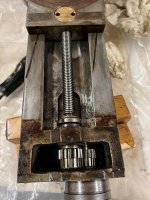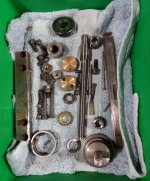Graziano SAG14 Compound
I'm a brand new machinist and this is my first lathe (so excited!!). The carriage and cross slide move smoothly and freely. However, the compound was very rough and binding, to the point of totally locked up. I took it apart, and originally thought the problem was in the bronze (brass?) lead screw nuts. However, they seem to move smoothly along the lead screw. However, if I put even a small amount of radial force on the lead screw, it binds and won't rotate. My conclusion is the lead screw bearing is toast, probably from lack of lubrication.
Is there any advice on how to proceed? Should I just remove the pin on the gear and remove the lead screw? Are bearings available? Any advice is greatly appreciated.
Thank you!
Jim
I'm a brand new machinist and this is my first lathe (so excited!!). The carriage and cross slide move smoothly and freely. However, the compound was very rough and binding, to the point of totally locked up. I took it apart, and originally thought the problem was in the bronze (brass?) lead screw nuts. However, they seem to move smoothly along the lead screw. However, if I put even a small amount of radial force on the lead screw, it binds and won't rotate. My conclusion is the lead screw bearing is toast, probably from lack of lubrication.
Is there any advice on how to proceed? Should I just remove the pin on the gear and remove the lead screw? Are bearings available? Any advice is greatly appreciated.
Thank you!
Jim
















